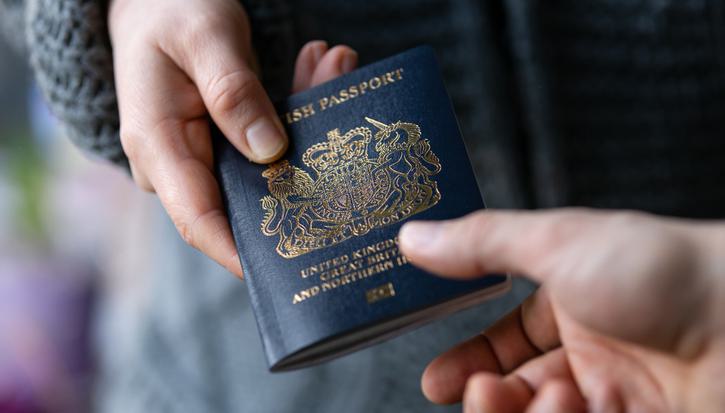
The asylum backlog: Job done?
Article
This blog post sets out how the department must now grapple with a new set of backlog challenges.
At the beginning of the year, the Home Office announced what seemed like a rare success: the prime minister’s target to clear the ‘legacy’ asylum backlog had been met. After years of a growing caseload and rising costs, it appeared the Home Office had finally turned a corner.
But in reality the Home Office’s troubles with the backlog are far from over.
How did the backlog get so large?
To explain the current situation, we need to go back to how the asylum backlog came about. For most of the 2010s, the backlog was relatively low: numbers awaiting an initial decision on their claim were well under 30,000. But between 2018 and 2022, the total number of claimants sharply increased, reaching a peak of around 175,000 in June 2023.
In large part, the growth in the backlog was driven by a slowdown in processing rates
In large part, the growth in the backlog was driven by a slowdown in processing rates. The share of applications processed within six months fell from around 78 per cent in 2015 to around 15 per cent in 2022. Productivity of asylum caseworkers more than halved between 2012/13 and 2022/23, even as the number of decision-makers increased. When combined with a rise in asylum claims, due to the recent surge in small boat arrivals, this led to a backlog on a scale not seen since the previous peak in the late 1990s.
The backlog has proved extremely costly. While claimants are awaiting a decision, the Home Office is responsible for providing accommodation and financial support to people who appear destitute (or appear likely to become so). Given the limits of the asylum estate, the government has increasingly made use of ‘contingency accommodation’ – largely hotels, as well as other sites such as the ex-RAF Wethersfield base and the Bibby Stockholm barge. This has driven up the total costs of the asylum system, which stood at around £3.97 billion in 2022/23, compared with £500 million a decade earlier.
What has the government done about it?
In December 2022, prime minister Rishi Sunak pledged to eliminate the ‘legacy backlog’ – defined as those claims made before 28 June 2022 – by the end of 2023. The legacy backlog at that point stood at over 90,000.
In parallel, the government has taken a series of steps aimed at meeting this deadline. The number of asylum caseworking staff doubled from 1,237 FTE in December 2022 to 2,405 FTE in December 2023. Productivity of caseworkers has also started to increase: in 2022, productivity was at around 5 principal stages (ie substantive interviews and decisions) per caseworker, while in the first nine months of 2023, productivity rose to around 7 principal stages per caseworker.
A key part of the government’s plan has been a new approach to streamlining asylum processing
A key part of the government’s plan has been a new approach to streamlining asylum processing. A new asylum questionnaire was rolled out in 2023 to replace substantive interviews for nationals from countries with very high grant rates – including Afghanistan, Eritrea, Libya, Syria and Yemen – provided they arrived before 7 March 2023. (Sudanese nationals are also subject to the streamlined process, but their claims are only in scope when they were made on or after 28 June 2022.) This has allowed decisions on manifestly well-founded cases to be made quickly without a substantive interview (or in some cases with a shorter or targeted interview).
Where does this leave the backlog now?
Overall, these changes have led the Home Office to make a record number of asylum decisions in recent months. There were around 50,000 initial decisions in the last three months of 2023, about five times as many as in the equivalent period a year earlier. The majority of legacy cases have therefore now been resolved and the overall backlog has started to slowly fall.
Yet the road ahead is far from smooth. There are two challenges for the government going forward. First, while the legacy backlog is mostly gone, the backlog as a whole is far from cleared: there were 98,599 cases remaining as of 28 December 2023, many of which will prove difficult to resolve. Second, the effort to race through the legacy backlog will create a new set of pressures on other parts of the asylum system. Each of these challenges are explored below in turn.
What about the remaining backlog of asylum cases?
The remaining asylum cases – numbering nearly 100,000 – can be split into five different cohorts.
1. First, there is the remainder of the legacy backlog, made up of claims lodged before 28 June 2022. While most of these claims have now been processed, figures from late December 2023 suggest that around 4,500 ‘complex cases’ are left. These include cases involving age assessments or people with serious medical concerns or potential criminal records.
2. Next is the NABA (Nationality and Borders Act) cohort – applications made on or after the key provisions of NABA came into force on 28 June 2022, but relating to people who arrived before the introduction of the illegal migration bill in Parliament on 7 March 2023. This cohort is subject to a tougher two-stage process for assessing asylum than earlier claims.
Moreover, cases in this cohort can be deemed inadmissible to the asylum system where they have a ‘connection’ to a safe third country (eg where they passed through it, were eligible to make a claim, and would have been reasonably expected to do so, but did not). Home Office guidance suggests cases considered for inadmissibility action should ultimately be admitted for asylum processing if no country will accept them for removal within a reasonable timescale, but in practice it appears many have been stuck in the inadmissibility process for lengthy periods: the Home Office recently announced that people arriving since 2022 who were issued inadmissibility letters before 29 June 2023 stating they may be sent to Rwanda have currently had all action paused. As of 28 December 2023, there were around 38,500 NABA cases remaining.
The second challenge for the government is that its efforts to clear the legacy backlog are now placing pressure on other parts of the asylum system
3. The illegal migration bill cohort relates, in broad terms, to people who arrived irregularly in the UK on or after 7 March 2023 – when the Illegal Migration Act (IMA) was introduced to Parliament – but before 20 July 2023 – when it received Royal Assent. This group is subject to the same rules as the NABA cohort, but with an added complexity: under the IMA they generally cannot be granted leave to remain. This poses an awkward challenge given the Home Office would need to grant leave if they made a positive decision on a claim. The department could get round this by using a provision introduced by the Act which allows the home secretary to grant leave if not doing so would breach an international agreement such as the European Convention on Human Rights (ECHR).
As of 28 December 2023, there were around 22,400 asylum cases relating to applications made between 7 March and 20 July 2023. The bulk of such cases are likely to be in this cohort, as most will relate to irregular arrivals. According to a recent report, the Home Office put in place a ‘temporary barrier’ to stop the processing of these claims in December.
4. The Illegal Migration Act cohort covers those who arrived on or after the IMA received Royal Assent on 20 July 2023 and who meet the conditions in the Act – in simple terms, they arrived irregularly. The key provisions of the Act are not yet in force, but if they are introduced, then the home secretary will be obliged to remove people in this cohort from the UK and deem them permanently inadmissible to the asylum system.1 They can either be removed to their home country if it is included on the list of safe countries for returns or to a safe third country – ie Rwanda, if the government can make its plan viable.
As of December 28 2023, there were around 33,100 asylum claims made since 20 July 2023, the bulk of whom are likely to relate to people who have arrived irregularly. Given most irregular arrivals applying for asylum come from unsafe countries and so cannot be returned home and given the problems with removing people to Rwanda at scale, much of this cohort are likely to be trapped in a ‘perma-backlog’, unable to be processed or removed. While the key provisions of the Act are not yet in force, the Home Office has signalled that these claims are ‘pending the further stages of the inadmissibility procedure’. In practice, this cohort is currently in a state of limbo.
5. Finally, the preserved asylum cohort comprises claimants who arrived on or after 7 March 2023 but who do not meet the conditions in the IMA – ie they did not come to the UK irregularly – and so who can be granted asylum. This may, for instance, include people who arrived in the UK on a work or study visa but then applied for asylum as conditions in their home country worsened. The exact scale of this cohort is uncertain, but it is likely to be a relatively small share of the roughly 55,500 asylum applications made since 7 March 2023 (as of December 2023).
of the 17,316 cases withdrawn in the year ending 30 September 2023, only 18 per cent have left the UK
What are the consequences of the government’s recent backlog clearance?
The second challenge for the government is that its efforts to clear the legacy backlog are now placing pressure on other parts of the asylum system.
First, the surge in initial asylum decisions is likely to lead to a parallel surge in appeals. There are already signs of a rise in asylum appeals received by the First-tier Tribunal. In July-September 2023 there were around 3,900 receipts, a 111 per cent increase compared to a year earlier.
Second, many recent asylum decisions have in fact been withdrawals – including a large number of ‘implicit withdrawals’, where the Home Office withdraws the claim on the basis that individuals have not, for instance, responded quickly enough to a questionnaire or shown up to an asylum interview. In the first half of 2023, there were around 4,500 non-substantiated (implicit) withdrawals, more than four times higher than in the first half of 2022.
The problem is that, of the 17,316 cases withdrawn in the year ending 30 September 2023, only 18 per cent have left the UK. Of the remainder, 2,643 have re-engaged with the Home Office and received status, while 5,931 are being dealt with as casework by different Home Office teams. But a total of 5,598 (32 per cent) of withdrawals have lost contact altogether. Without status, this group may be working in the informal labour market and are at particular risk of destitution and exploitation.
All this lays bare how it is far from job done on the asylum backlog
Third, the rise in decision-making in recent months will mean an increase in people liable for removal – there were around 4,700 refusals in the third quarter of 2023, four times higher than the same period the year before. Managing these returns will be legally and logistically challenging, especially where refused claimants cannot be located or receiving countries do not cooperate. There will be further challenges if the IMA is implemented in full, since then returns for the IMA cohort can only be made to a specific list of safe countries – currently including EU/EEA states, Switzerland, and Albania, with India and Georgia to be added shortly.
Finally, the ramping up of asylum processing has led to exceptional levels of positive decisions: there were around 18,400 grants of protection in the third quarter of 2023. While this has meant growing numbers exiting Home Office hotels, the ‘move-on’ period is only 28 days, which means that many are now presenting as homeless to local authorities.
So what next?
All this lays bare how it is far from job done on the asylum backlog. Perhaps the biggest immediate challenge is how to deal with the post 7 March asylum cohorts. The Home Office appears to not be processing any of these claims – and indeed many in the earlier NABA cohort are also paused in the inadmissibility process. Even if the government were making initial decisions on the entire NABA cohort, we estimate that at current rates (averaging around 10-15,000 cases per month) it would get through this caseload by around March. After this, it appears most asylum processing would in effect grind to a halt.
Addressing the wider challenges will require a cross-cutting perspective, given the Home Office’s resource constraints, low morale among officials and legislative barriers in the form of the IMA. To tackle the backlog in its totality, a tough target will not be enough: the government will need to develop a wider strategy for asylum reform.
With thanks to Sarah Mulley, Rhys Clyne, Jon Featonby, Beatrice Stern, and Sonia Lenegan for their help in informing this analysis.
Related items

Dr Lucy Mort at the Home Affairs Committee discussing asylum accommodation

Citizenship: A race to the bottom?
The ability to move from temporary immigration status to settlement, and ultimately to citizenship, is the cornerstone of a fair and functional immigration system.
Hidden hardships: The immigration system and child poverty
Child poverty remains a persistent and deeply rooted issue in the UK.

